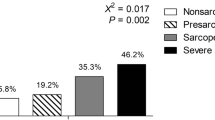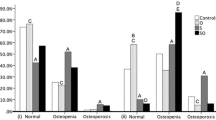Abstract
Summary
Both sarcopenia and low bone mineral density (BMD) have become public health concerns. We found that presarcopenic and/or sarcopenic individuals were more likely to have lower BMD. And this relationship has race and sex-specific discrepancy.
Purpose
The purpose of the study was to investigate the racial and gender differences in the relationship between sarcopenia and BMD among older adults.
Methods
Totally, 5476 subjects (mean age = 65.7 ± 6.4) of non-Hispanic White (n = 3297), non-Hispanic Black (n = 1265), and non-Hispanic Asian (n = 914) were analyzed. Sarcopenia was defined according to the revised European consensus on definition and diagnosis of sarcopenia (EWGSOP2). General linear model and multivariable linear regression model were used to examine the relationship between sarcopenia and regional/whole body BMD stratified by race and sex. Adjustments were conducted for physiological, behavioral, and disease factors.
Results
Comparing with normal older participants, presarcopenic and sarcopenic elderly were more likely to have lower BMD. Although the difference was not statistically significant in a few sub-groups, among the three racial groups, the strongest association between sarcopenia and BMD was found in non-Hispanic Black people, followed by non-Hispanic White people and non-Hispanic Asian people. In addition, significant differences of BMD across sarcopenia stages were found in more sub-groups in women than in men after adjusting for covariates.
Conclusions
In this older cohort, sarcopenia is significantly related to low regional/whole-body BMD, and these associations vary by race and sex. Consideration in race and sex is warranted when developing strategies to maintain or minimize BMD loss.


Similar content being viewed by others
References
Baumgartner RN, Koehler KM, Gallagher D, Romero L, Heymsfield SB, Ross RR, Garry PJ, Lindeman RD (1998) Epidemiology of sarcopenia among the elderly in New Mexico. Am J Epidemiol 147:755–763
Cruz-Jentoft AJ, Bahat G, Bauer J, Boirie Y, Bruyère O, Cederholm T, Cooper C, Landi F, Rolland Y, Sayer AA, Schneider SM, Sieber CC, Topinkova E, Vandewoude M, Visser M, Zamboni M, Writing Group for the European Working Group on Sarcopenia in Older People 2 (EWGSOP2) (2019) Sarcopenia: revised European consensus on definition and diagnosis. Age Ageing 48(1):16–31
Shafiee G, Keshtkar A, Soltani A, Ahadi Z, Larijani B, Heshmat R (2017) Prevalence of sarcopenia in the world: a systematic review and meta-analysis of general population studies. J Diabetes Metab Disord 16:21
Goates S, Du K, Arensberg MB, Gaillard T, Guralnik J, Pereira SL (2019) Economic impact of hospitalizations in US adults with sarcopenia. J Frailty Aging 8:93–99
Compston J (2010) Osteoporosis: social and economic impact. Radiol Clin N Am 48:477–482
Mariconda M, Costa GG, Cerbasi S, Recano P, Orabona G, Gambacorta M, Misasi M (2016) Factors predicting mobility and the change in activities of daily living after hip fracture: a 1-year prospective cohort study. J Orthop Trauma 30:71–77
Drake MT, Murad MH, Mauck KF et al (2012) Clinical review. Risk factors for low bone mass-related fractures in men: a systematic review and meta-analysis. J Clin Endocrinol Metab 97:1861–1870
Kanis JA, Burlet N, Cooper C, Delmas PD, Reginster JY, Borgstrom F, Rizzoli R (2008) European guidance for the diagnosis and management of osteoporosis in postmenopausal women. Osteoporos Int 19:399–428
Lee JJ, Aghdassi E, Cheung AM et al (2012) Ten-year absolute fracture risk and hip bone strength in Canadian women with systemic lupus erythematosus. J Rheumatol 39:1378–1384
Nelson HD, Haney EM, Dana T, Bougatsos C, Chou R (2010) Screening for osteoporosis: an update for the U.S. Preventive Services Task Force. Ann Intern Med 152(2):99–111
Schurman L, Bagur A, Claus-Hermberg H, Messina OD, Negri AL, Sánchez A, González C, Diehl M, Rey P, Gamba J, Chiarpenello J, Moggia MS, Mastaglia S (2013) Guidelines for the diagnosis, prevention and treatment of osteoporosis, 2012. Medicina 73:55–74
Kanis JA (2007) WHO Technical Report. University of Sheffield, UK, p 66
Burge R, Dawson-Hughes B, Solomon DH, Wong JB, King A, Tosteson A (2007) Incidence and economic burden of osteoporosis-related fractures in the United States, 2005-2025. J Bone Miner Res 22:465–475
Edwards MH, Dennison EM, Aihie Sayer A, Fielding R, Cooper C (2015) Osteoporosis and sarcopenia in older age. Bone 80:126–130
Pisani P, Renna MD, Conversano F, Casciaro E, Di Paola M, Quarta E, Muratore M, Casciaro S (2016) Major osteoporotic fragility fractures: risk factor updates and societal impact. World J Orthop 7:171–181
Curtis E, Litwic A, Cooper C, Dennison E (2015) Determinants of muscle and bone aging. J Cell Physiol 230:2618–2625
Looker AC, Melton LJ, Harris T, Borrud L, Shepherd J, McGowan J (2009) Age, gender, and race/ethnic differences in total body and subregional bone density. Osteoporos Int 20:1141–1149
Verschueren S, Gielen E, O’Neill TW, Pye SR, Adams JE, Ward KA, Wu FC, Szulc P, Laurent M, Claessens F, Vanderschueren D, Boonen S (2013) Sarcopenia and its relationship with bone mineral density in middle-aged and elderly European men. Osteoporos Int 24:87–98
Blain H, Vuillemin A, Teissier A, Hanesse B, Guillemin F, Jeandel C (2001) Influence of muscle strength and body weight and composition on regional bone mineral density in healthy women aged 60 years and over. Gerontology 47:207–212
Deng HW, Shen H, Xu FH, Deng HY, Conway T, Zhang HT, Recker RR (2002) Tests of linkage and/or association of genes for vitamin D receptor, osteocalcin, and parathyroid hormone with bone mineral density. J Bone Miner Res Off J Am Soc Bone Miner Res 17(4):678–686. https://doi.org/10.1359/jbmr.2002.17.4.678
Du Y, Zhao LJ, Xu Q, Wu KH, Deng HW (2017) Socioeconomic status and bone mineral density in adults by race and gender: the Louisiana osteoporosis study. Osteoporos Int 28:1699–1709
Kim J, Wang Z, Heymsfield SB, Baumgartner RN, Gallagher D (2002) Total-body skeletal muscle mass: estimation by a new dual-energy X-ray absorptiometry method. Am J Clin Nutr 76:378–383
Carey G (2013) Chapter 9 The General Linear Model (GLM): A gentle introduction. In: Quantitative Methods In Neuroscience. http://psych.colorado.edu/~carey/qmin/QMIN_2013_03_17.pdf. Accessed 05 May2019
He H, Liu Y, Tian Q, Papasian CJ, Hu T, Deng HW (2016) Relationship of sarcopenia and body composition with osteoporosis. Osteoporos Int 27:473–482
Cheng Q, Zhu X, Zhang X, Li H, Du Y, Hong W, Xue S, Zhu H (2014) A cross-sectional study of loss of muscle mass corresponding to sarcopenia in healthy Chinese men and women: reference values, prevalence, and association with bone mass [J]. J Bone Miner Metab 32(1):78–88
Taaffe DR, Cauley JA, Danielson M, Nevitt MC, Lang TF, Bauer DC, Harris TB (2001) Race and sex effects on the association between muscle strength, soft tissue, and bone mineral density in healthy elders: the Health, Aging, and Body Composition Study. J Bone Miner Res 16:1343–1352
Farber CR (2012) Systems genetics: a novel approach to dissect the genetic basis of osteoporosis [J]. Curr Osteoporos Rep 10(3):228–235
Travison TG, Chiu GR, McKinlay JB, Araujo AB (2011) Accounting for racial/ethnic variation in bone mineral content and density: the competing influences of socioeconomic factors, body composition, health and lifestyle, and circulating androgens and estrogens [J]. Osteoporos Int 22(10):2645–2654
Megyesi MS, Hunt LM, Brody H (2011) A critical review of racial/ethnic variables in osteoporosis and bone density research [J]. Osteoporos Int 22(6):1669–1679
Lima RM, de Oliveira RJ, Raposo R, Neri SGR, Gadelha AB (2019) Stages of sarcopenia, bone mineral density, and the prevalence of osteoporosis in older women [J]. Arch Osteoporos 14(1):38
Blain H, Vuillemin A, Teissier A (2001) Influence of muscle strength and body weight and composition on regional bone mineral density in healthy women aged 60 years and over [J]. Gerontology 47(4):207–212
Kim KM, Lee EY, Lim S, Jang HC, Kim CO (2017) Favorable effects of skeletal muscle on bone are distinguished according to gender and skeletal sites [J]. Osteoporos Sarcopenia 3(1):32–36
Silva MJ (2007) Biomechanics of osteoporotic fractures [J]. Injury 38(Suppl 3):S69–S76
Ribom E, Ljunggren O, Piehl-Aulin K, Ljunghall S, Bratteby LE, Samuelson G, Mallmin H (2004) Muscle strength correlates with total body bone mineral density in young women but not in men [J]. Scand J Med Sci Sports 14(1):24–29
Bevier WC, Wiswell RA, Pyka G, Kozak KC, Newhall KM, Marcus R (1989) Relationship of body composition, muscle strength, and aerobic capacity to bone mineral density in older men and women [J]. J Bone Miner Res 4(3):421–432
Philippou A, Maridaki M, Halapas A, Koutsilieris M (2007) The role of the insulin-like growth factor 1 (IGF-1) in skeletal muscle physiology [J]. In Vivo 21(1):45–54
Wright NC, Looker AC, Saag KG, Curtis JR, Delzell ES, Randall S, Dawson-Hughes B (2014) The recent prevalence of osteoporosis and low bone mass in the United States based on bone mineral density at the femoral neck or lumbar spine [J]. J Bone Miner Res 29(11):2520–2526
Reginster JY, Burlet N (2006) Osteoporosis: a still increasing prevalence [J]. Bone 38(2 Suppl 1):S4–S9
Janssen I, Heymsfield SB, Ross R (2002) Low relative skeletal muscle mass (sarcopenia) in older persons is associated with functional impairment and physical disability. J Am Geriatr Soc 50(5):889–896
Travison T, Chiu G, McKinlay J, Araujo A (2011) Accounting for racial/ethnic variation in bone mineral content and density: the competing influences of socioeconomic factors, body composition, health and lifestyle, and circulating androgens and estrogens. Osteoporos Int 22:2645–2654
Navarro MC, Saavedra P, Jódar E, Gómez DT, Mirallave A, Sosa M (2013) Osteoporosis and metabolic syndrome according to socioeconomic status, contribution of PTH, vitamin D and bodyweight: the Canarian osteoporosis poverty study (COPS). Clin Endocrinol 78:681–686
Lips P, van Schoor NM (2011) The effect of vitamin D on bone and osteoporosis. Best Pract Res Clin Endocrinol Metab 25(4):585–591
Girgis CM, Clifton-Bligh RJ, Hamrick MW, Holick MF, Gunton JE (2013) The roles of vitamin D in skeletal muscle: form, function, and metabolism. Endocr Rev 34(1):33–83
Gunton JE, Girgis CM (2018) Vitamin D and muscle. Bone Rep 8:163–167
Author information
Authors and Affiliations
Corresponding author
Ethics declarations
Conflicts of interest
None.
Additional information
Publisher’s note
Springer Nature remains neutral with regard to jurisdictional claims in published maps and institutional affiliations.
Supplementary Information
ESM 1
(DOCX 677 kb).
Appendix
Appendix
Rights and permissions
About this article
Cite this article
Ning, HT., Du, Y., Zhao, LJ. et al. Racial and gender differences in the relationship between sarcopenia and bone mineral density among older adults. Osteoporos Int 32, 841–851 (2021). https://doi.org/10.1007/s00198-020-05744-y
Received:
Accepted:
Published:
Issue Date:
DOI: https://doi.org/10.1007/s00198-020-05744-y




